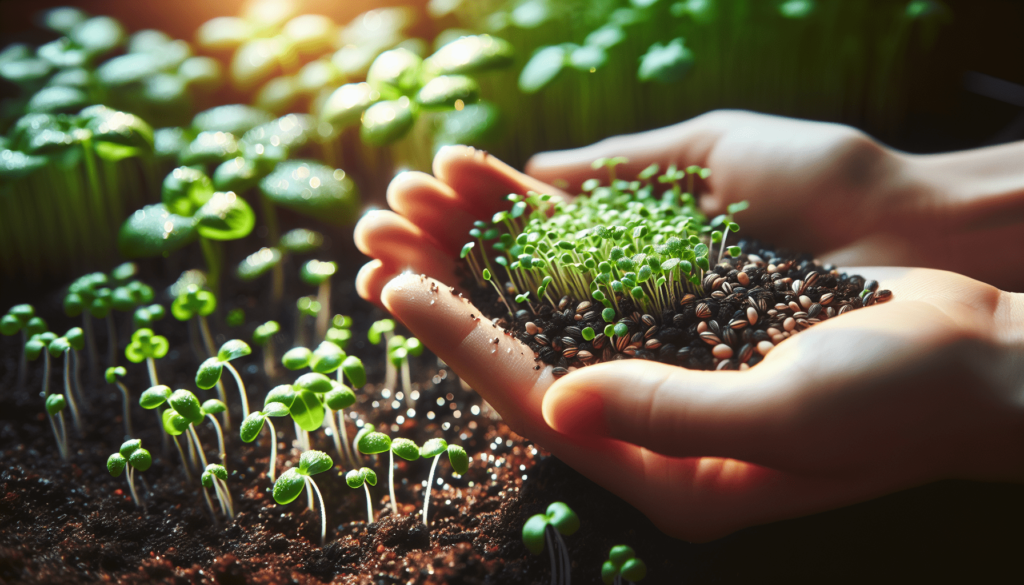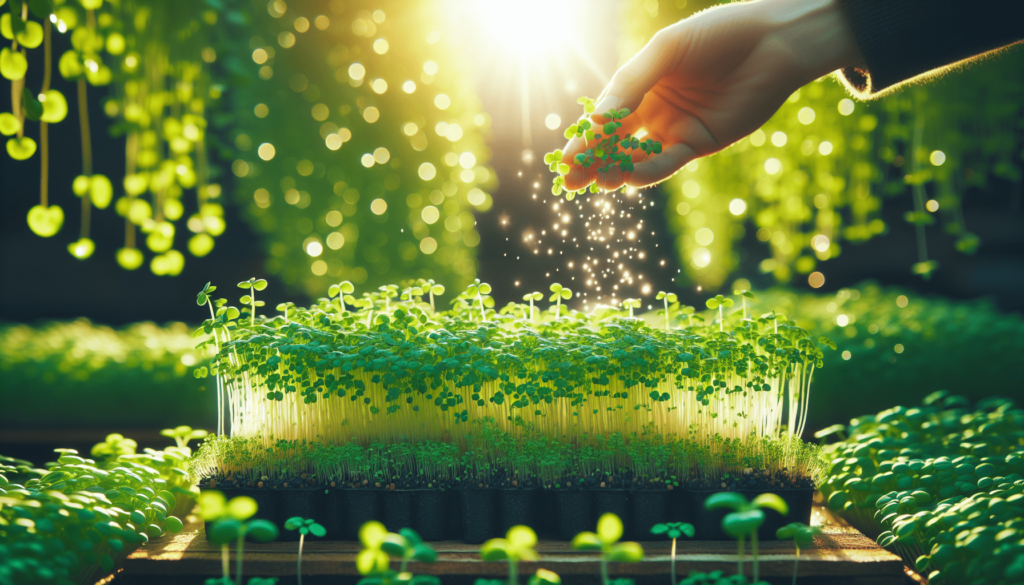So you have a passion for cooking and want to take your dishes to the next level? Look no further than the secret to growing fresh micro herbs with seeds. These delicate, flavorful herbs may be small in size but pack a punch when it comes to taste. With just a bit of patience, care, and the right techniques, you can have a constant supply of vibrant, aromatic micro herbs right at your fingertips. Say goodbye to store-bought herbs and hello to a whole new level of culinary delight.
Choosing the Right Seeds
When it comes to growing micro herbs, choosing the right seeds is crucial. Micro herbs are young, flavorful plants that add a fresh and vibrant taste to dishes and beverages. Understanding micro herb seeds is the first step in producing a successful harvest.
Understanding Micro Herb Seeds
Micro herb seeds are the tiny, dormant forms of the plants you want to grow. These seeds are specifically selected for their ability to produce tender, flavorful leaves and stems. Unlike full-grown herb plants, micro herbs are harvested at an early stage of growth, usually within 10-14 days after germination. This unique trait provides a concentrated burst of flavor and nutrition.
Quality and Freshness
Quality and freshness are essential when it comes to micro herb seeds. Look for reputable seed suppliers who specialize in micro herbs. Fresh seeds have a higher germination rate and yield healthier plants. When purchasing seeds, check the packaging for the date of harvest and expiration. It’s best to choose seeds that have been harvested within the last year for optimal results.
Organic and Non-GMO Seeds
For those concerned about the source of their food, choosing organic and non-GMO seeds is essential. Organic seeds are grown without the use of synthetic pesticides, herbicides, and fertilizers. Non-GMO seeds are free from genetic modification, ensuring that your micro herbs are as natural and pure as possible. Going organic and non-GMO not only benefits your health but also supports sustainable agriculture practices.
Variety Selection
Micro herbs come in a wide variety of flavors and colors, allowing you to experiment and create unique culinary experiences. When selecting your micro herb seeds, consider the flavors and aromas you enjoy. Popular micro herb varieties include basil, cilantro, chives, dill, and parsley. Don’t limit yourself to just one variety – mix and match to create exciting combinations in your dishes and drinks.
Preparing the Growing Environment
Creating the ideal growing environment for your micro herbs sets the stage for healthy and productive plants. Paying attention to details such as the growing container, soil, drainage, temperature, and lighting conditions will ensure that your micro herbs thrive.
Choosing a Growing Container
The choice of a growing container depends on the space you have available and your personal preference. Options range from traditional garden beds and pots to more innovative solutions like vertical gardens and hydroponic systems. Ensure that the container has adequate drainage holes to prevent waterlogging, as excessive moisture can cause root rot and other problems.
Selecting the Right Soil
Micro herbs prefer well-draining soil that is rich in organic matter. Look for a potting mix specifically formulated for herbs or create your own by combining equal parts of compost, peat moss, and perlite. Avoid using garden soil, as it tends to be heavy and may contain pathogens that can harm your plants. Consider adding organic fertilizer to provide essential nutrients for healthy growth.
Providing Adequate Drainage
Proper drainage is vital for the overall health of your micro herbs. Excess water needs to drain away to prevent root rot and fungal diseases. To ensure good drainage, use containers with drainage holes and place a layer of small stones or a drainage mat at the bottom of the container. This will allow water to flow freely and prevent water from stagnating around the roots.
Creating Optimal Temperature and Lighting Conditions
Micro herbs thrive in moderate temperatures between 60-75°F (15-24°C). Ensure that your growing environment maintains a consistent temperature within this range. Additionally, micro herbs require ample natural or artificial light to grow. Place your containers in a location that receives at least 6-8 hours of sunlight each day. If natural light is not sufficient, consider supplementing with fluorescent or LED grow lights to ensure optimal growth.

Germinating Micro Herb Seeds
Germination is the process where a seed sprouts and begins to grow into a new plant. Properly germinating micro herb seeds sets the stage for healthy and vigorous plants.
Pre-soaking Seeds
Some micro herb seeds benefit from pre-soaking before planting. This helps to soften the seed coat and kickstart the germination process. Fill a small container with lukewarm water and place the seeds inside for 12-24 hours. Seeds like basil, chia, and flax benefit from pre-soaking, but be sure to check the specific requirements of the seeds you are using.
Seed Surface Preparation
Before planting the seeds, it’s important to prepare the seed surface to enhance germination. Depending on the size and hardness of the seeds, there are a few methods you can use. For smaller seeds, gently rub them between two sheets of fine-grit sandpaper or place them in a small jar with sand and shake gently. This abrasion helps break the seed coat and allows water to penetrate more easily.
Seed Planting Techniques
When it’s time to plant your prepared micro herb seeds, follow the instructions on the seed packet. Most micro herb seeds should be sown thinly and evenly on the soil surface. Gently press the seeds into the soil, ensuring good contact. Some seeds require covering with a thin layer of soil or vermiculite, while others should be left uncovered. Refer to the seed packet for specific instructions.
Proper Moisture and Humidity
Maintaining proper moisture and humidity levels is crucial for seed germination. Keep the soil consistently moist but not waterlogged. Using a spray bottle to mist the soil surface helps avoid overwatering. To maintain humidity, cover the containers with plastic wrap or use a seedling dome. Remove the covering once the seeds have germinated to prevent mold and promote airflow.
Caring for Micro Herb Seeds
Proper care throughout the growth process is essential for healthy and productive micro herb plants. Pay attention to watering, fertilizing, pruning, and pest control to ensure success.
Watering and Fertilizing
Micro herb plants have small root systems that require careful watering. Avoid overwatering, as it can lead to root rot, while underwatering can cause the plants to wilt and suffer. Water the plants when the top inch of soil feels dry to the touch. It’s best to water from the bottom by placing the containers in a tray filled with water, allowing the plants to take up water through the drainage holes.
Fertilize your micro herbs with a balanced organic liquid fertilizer every two weeks or as indicated on the packaging. Dilute the fertilizer as instructed to avoid burning the delicate roots of the young plants. Organic fertilizers provide essential nutrients without the risk of chemical buildup.
Pruning and Maintaining Optimal Height
Pruning is an essential practice for micro herb plants, as it encourages bushier growth and prevents the plants from becoming leggy. Once your micro herbs have reached a height of 2-3 inches, snip off the top leaves using clean scissors or shears. This process, called “pinching,” prompts the plant to develop more lateral branches and leaves.
Maintaining the optimal height is important to make the most of your micro herbs. Harvest the leaves when they have reached the desired size, usually within 10-14 days after germination. Regularly harvest the tops of the plants to prevent them from elongating and becoming less flavorful.
Managing Pests and Diseases
Like other plants, micro herbs can be susceptible to pests and diseases. Keep a close eye on your plants and take preventive measures to avoid infestations. Inspect the leaves regularly for signs of damage, such as holes or discoloration, and remove any affected leaves immediately. If pests are present, try using natural remedies like neem oil or insecticidal soap to control the infestation.
To prevent diseases, avoid overcrowding your plants and provide good airflow by spacing them properly. Ensure that the growing environment is clean and free from fallen leaves or debris that can harbor pathogens. If diseases do occur, promptly remove the affected plants and sterilize any tools or containers to prevent further spread.
Preventing Overcrowding
Micro herb seeds are typically sown densely to maximize yield, but overcrowding can hinder growth and lead to disease susceptibility. Thin out your plants once they reach a height of 1-2 inches. Remove the weaker seedlings, leaving only the strongest ones to continue growing. This practice allows the remaining seedlings to develop properly and reduces competition for sunlight, water, and nutrients.

Harvesting Micro Herbs
The reward of growing micro herbs is the ability to harvest and enjoy fresh, flavorful leaves whenever you need them. Understanding the right time to harvest, the techniques involved, and proper storage will help you make the most of your homegrown micro herbs.
Determining the Right Time
Micro herbs are typically harvested when they have developed their first true leaves, which appear after the initial cotyledon leaves. The cotyledon leaves are embryonic leaves that initially provide the plant with energy until it can photosynthesize on its own. Once the true leaves have fully developed, you can begin harvesting. Harvesting too early may result in small, underdeveloped leaves, while waiting too long can cause the flavors to become overpowering or bitter.
Techniques for Harvesting
Harvesting micro herbs is a straightforward process. Using clean scissors or shears, cut the stems just above the soil level, ensuring that you leave enough growth for regrowth if desired. Harvesting the top leaves stimulates lateral branching and promotes a bushier plant. For herbs with woody stems such as rosemary or thyme, use pruning shears to avoid damaging the plant.
Allowing Regrowth for Multiple Harvests
One of the advantages of growing micro herbs is the ability to harvest multiple times from the same plant. After each harvest, the plants will regrow and produce a fresh batch of leaves. To allow for regrowth, leave a small portion of the plant intact, typically around 1 inch. With proper care and management, you can enjoy multiple harvests from each plant over a period of several weeks.
Storing Micro Herbs
To maximize the freshness and flavor of your micro herbs, it’s important to store them properly. Lightly mist the harvested herbs with water to keep them hydrated. Wrap the herbs loosely in a damp paper towel and place them in a zip-top bag. Alternatively, you can store them in an airtight container lined with a paper towel. Store the herbs in the refrigerator and use them within a week for optimal quality.
Troubleshooting Common Issues
Even with proper care, you may encounter some common issues while growing micro herbs. By identifying and addressing these problems promptly, you can ensure the health and vitality of your plants.
Slow or No Germination
If your micro herb seeds are slow to germinate or fail to germinate altogether, there are a few potential causes to consider. The most common cause is improper moisture levels. Check the soil to ensure it remains consistently moist, but not waterlogged. Another factor to consider is seed quality. If you suspect low-quality or old seeds, try purchasing fresh seeds from a reliable supplier. Finally, temperature fluctuations or insufficient lighting can also impact germination. Ensure that your growing environment provides the necessary conditions for seed germination.
Yellowing or Wilting Leaves
Yellowing or wilting leaves can be a sign of various problems, including overwatering, underwatering, nutrient deficiencies, or pests. Assess the moisture levels of the soil and adjust your watering accordingly. Check the condition of the roots – healthy roots are firm and white, while rotting roots are mushy and brown. Adjust your watering schedule to prevent overwatering or underwatering.
Inspect the leaves for any signs of pests such as aphids, spider mites, or whiteflies. Treat infestations with natural remedies or insecticides as needed. If nutrient deficiencies are suspected, consider supplementing with organic fertilizers or adjusting the pH level of the soil.
Fungal or Bacterial Infections
Fungal or bacterial infections can affect micro herbs, especially in environments with high humidity or poor airflow. To prevent these infections, ensure that your growing area is well-ventilated and not excessively humid. Avoid overcrowding your plants and maintain proper spacing to reduce the risk of infection. If an infection occurs, remove the affected plants and sterilize any tools or containers that came into contact with the infected plants.
Insect Infestations
Insect infestations can be a common issue in micro herb gardens. Aphids, spider mites, and other pests can damage the leaves and hinder plant growth. Regularly inspect your plants for signs of infestation, such as small insects or sticky residue on the leaves. Control infestations by using natural insecticidal soaps, neem oil, or introducing beneficial insects like ladybugs or lacewings. Prevention is key, so ensure that your plants are healthy, and the growing environment is clean and free from debris that can harbor pests.
Creative Uses for Micro Herbs
Micro herbs are not just limited to enhancing the flavors of your culinary creations. They have a range of creative uses that can elevate your meals, beverages, and even your beauty and wellness routines.
Garnishing and Enhancing Dishes
One of the most popular uses for micro herbs is as edible garnishes and enhancers for dishes. Sprinkle basil over a Caprese salad, cilantro on top of tacos, or dill over a plate of smoked salmon. The vibrant colors and delicate flavors of micro herbs add a visually appealing touch and a burst of fresh taste to any meal.
Flavoring Beverages and Cocktails
Micro herbs can also be used to infuse your favorite beverages and cocktails with a unique twist. Muddle a few leaves of mint or lavender in a glass to add freshness to lemonade or iced tea. Create herb-infused syrups by steeping micro herbs like rosemary or thyme in simple syrup, then use them to flavor cocktails or soda water. The possibilities are endless for creating refreshing, herb-infused beverages.
Creating Herb-Infused Oils and Vinegars
Preserve the flavors of your micro herbs by creating herb-infused oils and vinegars. Place a handful of herbs, such as basil or tarragon, in a clean glass jar and cover them with a high-quality olive oil or vinegar. Let the mixture infuse for a few weeks, then strain out the herbs. The resulting oils and vinegars can be used to dress salads, marinate meats, or as a flavorful dip for bread.
Incorporating in Homemade Beauty and Wellness Products
Micro herbs can also be incorporated into homemade beauty and wellness products. Create a DIY face toner by infusing chamomile or rosemary in witch hazel. Add a handful of lavender or thyme to a bath for a soothing and aromatic experience. The natural properties of micro herbs can enhance your self-care routine and add a touch of luxury to your daily life.
Expanding Your Micro Herb Garden
Once you’ve mastered the art of growing micro herbs, you may want to expand your garden and explore new varieties. Here are some tips for taking your micro herb garden to the next level.
Seed-Saving Techniques
If you want to save money and have a continuous supply of micro herb seeds, consider seed-saving techniques. Allow some plants to go to seed by letting them reach full maturity. Once the flowers have dried and developed seeds, collect them and store them in a cool, dry place for future use. Be aware that hybrid varieties may not produce true-to-type seeds, so it’s best to save seeds from open-pollinated or heirloom varieties.
Transplanting and Propagating
Transplanting and propagating micro herbs allow you to expand your garden without the need for additional seeds. Once your micro herbs have matured, carefully dig them up, ensuring you preserve as much of the root system as possible. Transplant them into larger containers or directly into your garden bed. Properly caring for the transplanted herbs will ensure their successful establishment.
Propagating micro herbs can be done through methods such as stem cuttings or division. Take stem cuttings from healthy plants, removing the lower leaves and placing them in water or a rooting medium. After a few weeks, the cuttings will develop roots and can be transplanted into soil. Division involves separating the root system of a mature plant into multiple smaller plants, each with its own root system.
Scaling Up Production
If you find yourself needing a larger supply of micro herbs, consider scaling up your production. This can be done by dedicating more space to your garden or setting up a dedicated growing area indoors. Utilize vertical growing systems or hydroponic setups to maximize the number of plants you can grow in a limited space. With careful planning and management, you can produce a bountiful harvest of micro herbs to enjoy and share with others.
Sharing Seeds and Plants with Others
One of the joys of gardening is sharing your love for plants with others. Consider sharing your surplus micro herb seeds or plants with friends, family, or community members. By sharing your knowledge and resources, you can inspire others to grow their own fresh micro herbs and spread the joy of homegrown goodness.
Tips for Success
To ensure a successful micro herb garden, here are some additional tips to keep in mind.
Maintaining Consistency
Consistency is key when it comes to growing micro herbs. Maintain consistent moisture levels, temperature, and lighting conditions to provide a stable environment for your plants. This consistent care will help your micro herbs thrive and produce the best flavors and yields.
Observing and Adjusting Growth Conditions
Each micro herb variety may have unique growth requirements. Observe your plants closely and make adjustments as needed. If certain plants are not thriving, assess the growing conditions and make changes accordingly. Micro herbs are responsive to their environment, so paying attention to their needs will improve the overall health and vitality of your garden.
Experimenting with Different Seeds and Varieties
Don’t be afraid to experiment with different seeds and varieties of micro herbs. Try growing lesser-known herbs or explore exotic flavors that pique your interest. The world of micro herbs is vast, and there are countless flavors and aromas to discover. Enjoy the process of experimentation and discover new favorites along the way.
Regularly Learning and Researching
Gardening is a continuous learning experience, and staying informed about the latest techniques and practices will benefit your micro herb garden. Regularly read books, articles, and online resources to expand your knowledge. Join gardening forums or communities to connect with fellow micro herb enthusiasts and share insights. The more you learn, the more successful and fulfilling your gardening journey will be.
Conclusion
Growing fresh micro herbs from seeds is a rewarding and enjoyable experience. By choosing the right seeds, preparing the growing environment, germinating the seeds, caring for the plants, and utilizing creative uses, you can enjoy a bountiful harvest of vibrant and flavorful micro herbs. Expand your garden, troubleshoot common issues, and follow these tips for success to create a thriving micro herb garden that brings joy and satisfaction to your culinary adventures. So go ahead, experiment, discover, and share the joy of homegrown micro herbs. Your taste buds will thank you!





